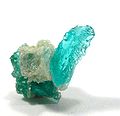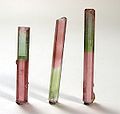Tourmaline - A Stone of Many Colors
 Whether you believe, as the ancient Egyptians did, that tourmaline gathered its colors on a trip across the rainbow, you prefer the more scientific explanation, one thing's for certain: Tourmaline comes in more colors than any other single gemstone!
Whether you believe, as the ancient Egyptians did, that tourmaline gathered its colors on a trip across the rainbow, you prefer the more scientific explanation, one thing's for certain: Tourmaline comes in more colors than any other single gemstone!
 The rarest colors of tourmaline are the unusual blue and green colored stones found only in the Batalha mine in Paraiba, Brazil. These stones, which have been described as having an electric, almost neon glow about them, get their unique color from the presence of copper. Similar specimens have been discovered in Nigeria. Jewelry featuring Paraiba tourmaline is available but pricey - some cut stones have sold for more per carat than fine diamonds! The most exquisite of these gems are rarely ever seen outside of gem collections.
The rarest colors of tourmaline are the unusual blue and green colored stones found only in the Batalha mine in Paraiba, Brazil. These stones, which have been described as having an electric, almost neon glow about them, get their unique color from the presence of copper. Similar specimens have been discovered in Nigeria. Jewelry featuring Paraiba tourmaline is available but pricey - some cut stones have sold for more per carat than fine diamonds! The most exquisite of these gems are rarely ever seen outside of gem collections.
 Also uncommon but more frequently seen in jewelry are the prized blue to blue-green Indicolite, the berry-red Rubellite, and bright emerald-green Chrome tourmaline. All of these are considered highly desirable, and cost more per carat than other tourmalines.
Also uncommon but more frequently seen in jewelry are the prized blue to blue-green Indicolite, the berry-red Rubellite, and bright emerald-green Chrome tourmaline. All of these are considered highly desirable, and cost more per carat than other tourmalines.
 The most common tourmaline colors are pink and the less-exotic shades of green. Additional hues include yellow, colorless (Achroite), dark yellow to brownish black (Dravite), violet (Siberite) and a dark black variety known as Schorl.
The most common tourmaline colors are pink and the less-exotic shades of green. Additional hues include yellow, colorless (Achroite), dark yellow to brownish black (Dravite), violet (Siberite) and a dark black variety known as Schorl.
 One of the most distinctive characteristics of tourmaline is that there can be more than one color in the same crystal! These crystals can be cut into a stone of each color or sometimes into a bi-colored, faceted stone. The most frequent combination is pink and green. These parti-colored gems are called watermelon tourmaline, though that term properly applies only to the stones which have one color like a "core" in the crystal with the other wrapped around it (like the green skin on a red watermelon).
One of the most distinctive characteristics of tourmaline is that there can be more than one color in the same crystal! These crystals can be cut into a stone of each color or sometimes into a bi-colored, faceted stone. The most frequent combination is pink and green. These parti-colored gems are called watermelon tourmaline, though that term properly applies only to the stones which have one color like a "core" in the crystal with the other wrapped around it (like the green skin on a red watermelon).
CC attribution for mineral photos on this page: Rob Lavinsky, iRocks.com – CC-BY-SA-3.0.
